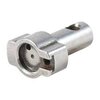Offering the counterpoint - almost all custom R700 clone actions from some of the most skilled and knowledgeable gun builders in the world use sako/M-16 type extractors. Bolt heads for controlled round feed actions also do not fully enclose the case head either.
The Remington marketing of “3 rings of steel” might have been a small, incremental safety enhancement for that model, but it’s kinda fearmongering to point to partially interrupted boltface rim as unsafe.
View attachment 1149755 View attachment 1149756 View attachment 1149757 View attachment 1149758
Take a look how Mauser extractors are supported. They are attached to the bolt in the middle, hooked to the front of the bolt, and fit under the right of the receiver rail.


When the bolt is closed, the Mauser extractor is far into the receiver ring and is hard to blow out. This is a "Mauser type" extractor on a M70, and clearly the action had excessive gas release, but the extractor did not blow out.

Mauser also designed gas venting and gas blocking features in his action that are not there in a Rem M700. Mike Walker designed his action so gas release would be contained by the bolt face.
BREECH CLOSING CONSTRUCTION FOR FIREARMS 2,585,195
Merle H. Walker, lion, N. Y., assignor to Remington Arms Company, Inc., Bridgeport, Conn., a corporation of Delaware Application
Prior art firearms of the type employing fixed metallic ammunition have always been dependent upon the metallic cartridge case for securing obturation with the walls of the barrel chamber and preventing the rearward escape of gas from the barrel. As a result, the head of high intensity center-fire rifle cartridges has always been a massive chunk of brass of usually adequate strength to bridge over gaps between the end of the bolt and the chamber mouth, or clearance cuts for extractors, ejectors, and the like. However, in spite of this massive construction, the heads of cartridges, due to metallurgical deficiencies, barrel obstructions, or other difficulties, all too often fail in service, releasing white hot gas at pressures in excess of 50,000 pounds per square inch into the interior of the receiver. With some modern commercial and military rifles the effects of a burst head are disastrous, completely wrecking the action and seriously injuring or killing the shooter. One of the better known military rifles presents in alignment with the shooter's face a straight line passage down the left hand bolt lug guide groove, which, even though the receiver proper does not blow up, channels high pressure gas and fragments of the cartridge head into the location where they can do the most damage. It has been often, and truthfully, said that the Strength of most rifles is no greater than that of the head of the cartridges intended for use therein. The primary object of this invention is the provision of a firearm construction which is not thus dependent upon the strength of a cartridge head, ordinarily formed of a material of relatively low strength by comparison with the ferrous alloys used for the firearm structure.
Cutting the bolt face ring will channel gases down into the action when a primer pops or the case head ruptures. Mike Walker designed his action to keep the gases in at the breech, so the action was not designed for the contingency of what happens if the bolt face ring is deliberately cut. The only thing keeping a SAKO or M16 extractor in place is a pivot pin. Those pivot pins are not that strong, nor were they ever designed to retain the extractor during massive, high pressure gas release. And, there is nothing in the action of a Rem M700 or M721 which will keep a SAKO/M16 extractor in place, nor keep one from blowing out of the action.
My SAKO Finnbear, I am 100% certain that the guide bar on the right side of the bolt is there to keep its extractor from blowing out during over pressure conditions. It is not really needed to guide the bolt.

These SAKO/M16 extractor conversions are an example of immature and half baked ideas that make a lot of money for some people. Sure, a SAKO extractor will probably last longer than a M700 extractor, but, the conversion on a Rem M700/M721 makes the action less safe.
Incidentally, Mauser seated his cartridge very deep in his action and that is great. The more case head sticks out of the chamber, the less well the case head is supported, the more likely the sidewall will rupture and vent gas into the action. These little things are very important.
This is a Mauser barrel

this is a M1903 barrel

the amount of unsupported case head is greater with the M1903, and the M98 has a ring inside the action surrounding the case head, except at the extractor groove. Mauser designed a very safe action, considering it is first and foremost, a military action. Mauser's tradeoffs were different from Mike Walker's. However, both actions are well thought out.
SAKO and M16 extractor conversions are not very well thought out, in my opinion.
















